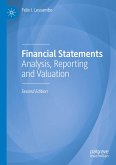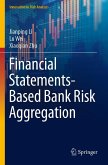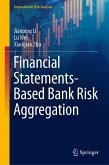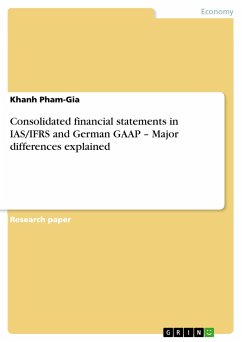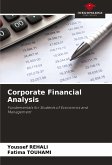- Broschiertes Buch
- Merkliste
- Auf die Merkliste
- Bewerten Bewerten
- Teilen
- Produkt teilen
- Produkterinnerung
- Produkterinnerung
Through a mixture of concepts and examples, this book demystifies the variety of elements of financial accounting and uncovers the need-to-know information for certification in this field. This book covers the two aspects of financial statement analysis, namely quantitative and non-quantitative analysis. Concluding with helpful case studies, the book will appeal to students and academics of financial accounting.
Andere Kunden interessierten sich auch für
![Financial Statements Financial Statements]() Felix I. LessamboFinancial Statements116,99 €
Felix I. LessamboFinancial Statements116,99 €![Financial Statements-Based Bank Risk Aggregation Financial Statements-Based Bank Risk Aggregation]() Jianping LiFinancial Statements-Based Bank Risk Aggregation108,99 €
Jianping LiFinancial Statements-Based Bank Risk Aggregation108,99 €![Financial Statements-Based Bank Risk Aggregation Financial Statements-Based Bank Risk Aggregation]() Jianping LiFinancial Statements-Based Bank Risk Aggregation108,99 €
Jianping LiFinancial Statements-Based Bank Risk Aggregation108,99 €![Consolidated financial statements in IAS/IFRS and German GAAP ¿ Major differences explained Consolidated financial statements in IAS/IFRS and German GAAP ¿ Major differences explained]() Khanh Pham-GiaConsolidated financial statements in IAS/IFRS and German GAAP ¿ Major differences explained18,95 €
Khanh Pham-GiaConsolidated financial statements in IAS/IFRS and German GAAP ¿ Major differences explained18,95 €![Financial Intelligence Financial Intelligence]() Karen BermanFinancial Intelligence26,99 €
Karen BermanFinancial Intelligence26,99 €![Corporate Financial Analysis Corporate Financial Analysis]() Youssef REHALICorporate Financial Analysis47,99 €
Youssef REHALICorporate Financial Analysis47,99 €![Financial Accounting Financial Accounting]() Adriana Du_escuFinancial Accounting66,99 €
Adriana Du_escuFinancial Accounting66,99 €-
-
-
Through a mixture of concepts and examples, this book demystifies the variety of elements of financial accounting and uncovers the need-to-know information for certification in this field. This book covers the two aspects of financial statement analysis, namely quantitative and non-quantitative analysis. Concluding with helpful case studies, the book will appeal to students and academics of financial accounting.
Produktdetails
- Produktdetails
- Verlag: Palgrave Macmillan / Springer International Publishing / Springer, Berlin
- Artikelnr. des Verlages: 978-3-030-40507-6
- 1st ed. 2018
- Seitenzahl: 370
- Englisch
- Abmessung: 210mm x 148mm x 21mm
- Gewicht: 511g
- ISBN-13: 9783030405076
- Artikelnr.: 58466635
- Herstellerkennzeichnung Die Herstellerinformationen sind derzeit nicht verfügbar.
- Verlag: Palgrave Macmillan / Springer International Publishing / Springer, Berlin
- Artikelnr. des Verlages: 978-3-030-40507-6
- 1st ed. 2018
- Seitenzahl: 370
- Englisch
- Abmessung: 210mm x 148mm x 21mm
- Gewicht: 511g
- ISBN-13: 9783030405076
- Artikelnr.: 58466635
- Herstellerkennzeichnung Die Herstellerinformationen sind derzeit nicht verfügbar.
Felix I. Lessambo is an Associate Professor at Central Connecticut State University's School of Business where he teaches Financial Statements Analysis and Global Financial Reporting. He has practiced international tax, transfer pricing, and alternative investment management groups where he structured and advised on hedge funds and private equity cross-border transactions. He is the author of several books in finance, including The International Banking System, The International Corporate Governance System, International Financial Institutions and Their Challenges, International Aspects of the US Taxation System, Audit-Assurance Services & Forensics, and Financial Statements: Analysis and Reporting.
Part 1. Overview of Financial Statements and the Statement of Position.- Chapter 1. Overview of Financial Statements.- Chapter 2. Cash and Cash Equivalents.- Chapter 3. Short-Term Assets: Inventories.- Chapter 4. Account Receivables.- Chapter 5. Pre-Paid Expenses, Unearned Income and Other Current Assets.- Chapter 6. Short-Term Liabilities and Working Capital.- Chapter 7. Long-Term Assets: Plant, Property and Equipment.- Chapter 8. Long Term Assets: Intangibles.- Chapter 9. Long-Term Liabilities: Leases.- Chapter 10. Long-Term Liabilities: Pension and Post-Retirement Liabilities.- Chapter 11. Shareholders' Equity.- Part 2. The Statement of Income.- Chapter 12. Analysis of the Statement of Income.- Chapter 13. Other Comprehensive Income.- Chapter 14. The Sub-Statement of Retained Earnings.- Chapter 15. The Computation of the Taxable Income.- Part 3. The Statement of Cash Flows and Financial Ratios.- Chapter 16. Analysis of the Statements of Cash Flows.- Chapter 17. Financial Ratios Analysis.- Part 4. Pro-Forma Financial Statements.- Chapter 18. Forecasting Financial Statements' Analysis.- Part 5. Consolidated Financial Statements.- Chapter 19. Foreign Currency Accounting.- Chapter 20. Consolidated Financial Statements.- Chapter 21. Segment and Intermediary Financial Statements.- Chapter 22. IFRS and GAAP.- Part 6. Case Study.- Chapter 23. Apple and Microsoft Case Study.
Part 1. Overview of Financial Statements and the Statement of Position.
Chapter 1. Overview of Financial Statements.
Chapter 2. Cash and Cash Equivalents.
Chapter 3. Short
Term Assets: Inventories.
Chapter 4. Account Receivables.
Chapter 5. Pre
Paid Expenses, Unearned Income and Other Current Assets.
Chapter 6. Short
Term Liabilities and Working Capital.
Chapter 7. Long
Term Assets: Plant, Property and Equipment.
Chapter 8. Long Term Assets: Intangibles.
Chapter 9. Long
Term Liabilities: Leases.
Chapter 10. Long
Term Liabilities: Pension and Post
Retirement Liabilities.
Chapter 11. Shareholders' Equity.
Part 2. The Statement of Income.
Chapter 12. Analysis of the Statement of Income.
Chapter 13. Other Comprehensive Income.
Chapter 14. The Sub
Statement of Retained Earnings.
Chapter 15. The Computation of the Taxable Income.
Part 3. The Statement of Cash Flows and Financial Ratios.
Chapter 16. Analysis of the Statements of Cash Flows.
Chapter 17. Financial Ratios Analysis.
Part 4. Pro
Forma Financial Statements.
Chapter 18. Forecasting Financial Statements' Analysis.
Part 5. Consolidated Financial Statements.
Chapter 19. Foreign Currency Accounting.
Chapter 20. Consolidated Financial Statements.
Chapter 21. Segment and Intermediary Financial Statements.
Chapter 22. IFRS and GAAP.
Part 6. Case Study.
Chapter 23. Apple and Microsoft Case Study¿.
Part 6: Non
GAAP Reporting & Earnings Management.
Chapter 24. Non
GAAP Reporting.
Chapter 25. Earnings Management through Excessive Reserves and Provisions.
Part 7: Valuation.
Chapter 26. Valuation Accounting.
Chapter 1. Overview of Financial Statements.
Chapter 2. Cash and Cash Equivalents.
Chapter 3. Short
Term Assets: Inventories.
Chapter 4. Account Receivables.
Chapter 5. Pre
Paid Expenses, Unearned Income and Other Current Assets.
Chapter 6. Short
Term Liabilities and Working Capital.
Chapter 7. Long
Term Assets: Plant, Property and Equipment.
Chapter 8. Long Term Assets: Intangibles.
Chapter 9. Long
Term Liabilities: Leases.
Chapter 10. Long
Term Liabilities: Pension and Post
Retirement Liabilities.
Chapter 11. Shareholders' Equity.
Part 2. The Statement of Income.
Chapter 12. Analysis of the Statement of Income.
Chapter 13. Other Comprehensive Income.
Chapter 14. The Sub
Statement of Retained Earnings.
Chapter 15. The Computation of the Taxable Income.
Part 3. The Statement of Cash Flows and Financial Ratios.
Chapter 16. Analysis of the Statements of Cash Flows.
Chapter 17. Financial Ratios Analysis.
Part 4. Pro
Forma Financial Statements.
Chapter 18. Forecasting Financial Statements' Analysis.
Part 5. Consolidated Financial Statements.
Chapter 19. Foreign Currency Accounting.
Chapter 20. Consolidated Financial Statements.
Chapter 21. Segment and Intermediary Financial Statements.
Chapter 22. IFRS and GAAP.
Part 6. Case Study.
Chapter 23. Apple and Microsoft Case Study¿.
Part 6: Non
GAAP Reporting & Earnings Management.
Chapter 24. Non
GAAP Reporting.
Chapter 25. Earnings Management through Excessive Reserves and Provisions.
Part 7: Valuation.
Chapter 26. Valuation Accounting.
Part 1. Overview of Financial Statements and the Statement of Position.- Chapter 1. Overview of Financial Statements.- Chapter 2. Cash and Cash Equivalents.- Chapter 3. Short-Term Assets: Inventories.- Chapter 4. Account Receivables.- Chapter 5. Pre-Paid Expenses, Unearned Income and Other Current Assets.- Chapter 6. Short-Term Liabilities and Working Capital.- Chapter 7. Long-Term Assets: Plant, Property and Equipment.- Chapter 8. Long Term Assets: Intangibles.- Chapter 9. Long-Term Liabilities: Leases.- Chapter 10. Long-Term Liabilities: Pension and Post-Retirement Liabilities.- Chapter 11. Shareholders' Equity.- Part 2. The Statement of Income.- Chapter 12. Analysis of the Statement of Income.- Chapter 13. Other Comprehensive Income.- Chapter 14. The Sub-Statement of Retained Earnings.- Chapter 15. The Computation of the Taxable Income.- Part 3. The Statement of Cash Flows and Financial Ratios.- Chapter 16. Analysis of the Statements of Cash Flows.- Chapter 17. Financial Ratios Analysis.- Part 4. Pro-Forma Financial Statements.- Chapter 18. Forecasting Financial Statements' Analysis.- Part 5. Consolidated Financial Statements.- Chapter 19. Foreign Currency Accounting.- Chapter 20. Consolidated Financial Statements.- Chapter 21. Segment and Intermediary Financial Statements.- Chapter 22. IFRS and GAAP.- Part 6. Case Study.- Chapter 23. Apple and Microsoft Case Study.
Part 1. Overview of Financial Statements and the Statement of Position.
Chapter 1. Overview of Financial Statements.
Chapter 2. Cash and Cash Equivalents.
Chapter 3. Short
Term Assets: Inventories.
Chapter 4. Account Receivables.
Chapter 5. Pre
Paid Expenses, Unearned Income and Other Current Assets.
Chapter 6. Short
Term Liabilities and Working Capital.
Chapter 7. Long
Term Assets: Plant, Property and Equipment.
Chapter 8. Long Term Assets: Intangibles.
Chapter 9. Long
Term Liabilities: Leases.
Chapter 10. Long
Term Liabilities: Pension and Post
Retirement Liabilities.
Chapter 11. Shareholders' Equity.
Part 2. The Statement of Income.
Chapter 12. Analysis of the Statement of Income.
Chapter 13. Other Comprehensive Income.
Chapter 14. The Sub
Statement of Retained Earnings.
Chapter 15. The Computation of the Taxable Income.
Part 3. The Statement of Cash Flows and Financial Ratios.
Chapter 16. Analysis of the Statements of Cash Flows.
Chapter 17. Financial Ratios Analysis.
Part 4. Pro
Forma Financial Statements.
Chapter 18. Forecasting Financial Statements' Analysis.
Part 5. Consolidated Financial Statements.
Chapter 19. Foreign Currency Accounting.
Chapter 20. Consolidated Financial Statements.
Chapter 21. Segment and Intermediary Financial Statements.
Chapter 22. IFRS and GAAP.
Part 6. Case Study.
Chapter 23. Apple and Microsoft Case Study¿.
Part 6: Non
GAAP Reporting & Earnings Management.
Chapter 24. Non
GAAP Reporting.
Chapter 25. Earnings Management through Excessive Reserves and Provisions.
Part 7: Valuation.
Chapter 26. Valuation Accounting.
Chapter 1. Overview of Financial Statements.
Chapter 2. Cash and Cash Equivalents.
Chapter 3. Short
Term Assets: Inventories.
Chapter 4. Account Receivables.
Chapter 5. Pre
Paid Expenses, Unearned Income and Other Current Assets.
Chapter 6. Short
Term Liabilities and Working Capital.
Chapter 7. Long
Term Assets: Plant, Property and Equipment.
Chapter 8. Long Term Assets: Intangibles.
Chapter 9. Long
Term Liabilities: Leases.
Chapter 10. Long
Term Liabilities: Pension and Post
Retirement Liabilities.
Chapter 11. Shareholders' Equity.
Part 2. The Statement of Income.
Chapter 12. Analysis of the Statement of Income.
Chapter 13. Other Comprehensive Income.
Chapter 14. The Sub
Statement of Retained Earnings.
Chapter 15. The Computation of the Taxable Income.
Part 3. The Statement of Cash Flows and Financial Ratios.
Chapter 16. Analysis of the Statements of Cash Flows.
Chapter 17. Financial Ratios Analysis.
Part 4. Pro
Forma Financial Statements.
Chapter 18. Forecasting Financial Statements' Analysis.
Part 5. Consolidated Financial Statements.
Chapter 19. Foreign Currency Accounting.
Chapter 20. Consolidated Financial Statements.
Chapter 21. Segment and Intermediary Financial Statements.
Chapter 22. IFRS and GAAP.
Part 6. Case Study.
Chapter 23. Apple and Microsoft Case Study¿.
Part 6: Non
GAAP Reporting & Earnings Management.
Chapter 24. Non
GAAP Reporting.
Chapter 25. Earnings Management through Excessive Reserves and Provisions.
Part 7: Valuation.
Chapter 26. Valuation Accounting.


